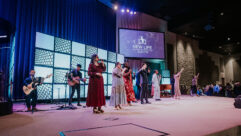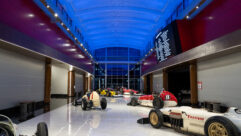SVC Podcast – Show Notes –
In this edition of the SVC Podcast, Contributing Editor Bennett Liles wraps up his conversation with Attraction Designer Ryan McCurdy about the design and installation of the AV effects for the American Prohibition Museum in Savannah, Georgia. Ryan provides details on video projection, lighting instruments and automated sound control. He also discusses rehearsals for getting live actors and all of the AV machinery working together.
Links of Interest:
- Panasonic PT-RZ670 8000 lumen projector
- Samsung ED75E Direct-Lit LED Display
- Source Four Lighting Instruments
Download Podcast Here:
https://s3.amazonaws.com/nb-svc/public/public/191-2_Prohibition_Museum_M…
This is the SVC Podcast from Sound & Video Contractor Magazine with Attraction Designer Ryan McCurdy. We’ve got show notes and product links for this interview and other SVC podcasts at svconline.com.
The American Prohibition Museum in Savannah, Georgia immerses visitors in an incredible lighting, video and sound experience. Live actors mix with AV effects and playback to intensify the effects. Attraction Designer Ryan McCurdy is back to finish his story on how he equipped the whole thing and brought it to life, all right here on the SVC Podcast.
Ryan it’s good to have you back with us and Historic Tours of America’s new Prohibition Museum in Savannah, Georgia. You rigged the whole thing out as you’ve done with some previous historic exhibits and it’s fascinating how you mix AV machinery with live actors. How do you project such convincing video images in such a small space?
Good question. A very good question. And it was a long process of dialogue about how we were going to do this. And so we have what are called prestige effects. It’s the word I sort of coined. It’s the effects that the patrons are most likely to stop and fixate on. They’re actually all being fed by a Binloop HD from Alcorn McBride. But we realized that all of the effects actually could convincingly work in high-def 4K monitors rather than projectors. So while there are some projectors in the space – in fact, the very first thing you see after you walk into the museum is a Panasonic PTRZ-670 that is projecting a huge montage of Prohibition Era images onto a wall. We do use that for archival footage. We have another place where we’re projecting what was called “The Death of John Barleycorn,” which was a fake funeral staged when prohibition was enacted. But then for our prestige effect, which are the film sequences that we filmed specifically for the museum, we have the talking portraits, which I think we talked about in Part 1, and we have a moonshiner character. And there was a lot of discussion about whether we should use a Musion Eyeliner type system and do a hologram, whether we should do a standard projection against a blank surface. And then ultimately we realized that we didn’t have the depth to either do Musion or do a straight projector. We also didn’t want to deal with the noise and we didn’t want to deal with the fact that we wanted possibly smoke in the environment, and sort of it’s an outside environment which has been really lovingly detailed by the art department headed by Monte Triz. So we didn’t want to shut down any opportunities for water effects or mist effects, so what we basically have done – and I think it looks and feels very, very great – is we’re using a high end Samsung ED75E, which is one of their 4K 75-inch monitors. And it is embedded and inset into a huge backdrop that was hand painted by Monte Triz and his team. And then what we did is shot the moonshiner against a green screen, replaced the green screen painstakingly, the film departments and our post-production teams from Media Merge in Alabama and R.J. Temple, Jr. was one of our post-production sound team workers. They worked to replace the green screen with an actual representation of what the mural from the backdrop is. And then the monitor itself is framed between two real trees that have been inserted into the space so it really looks like he just happens to exist between this – in this one little area of the backdrop. And he interacts with his environment. He reaches up and turns on a practical lamp, turns it off. He reaches down and picks things up that look like they could be from the table right in front of him. It’s these crafty little integrations of real world interaction, as well as the live sound and the live lights, that I think convince most people that he is there in a way that I think we would have always fought with a projection. And the thing I was most worried about projection-wise, which we do run into in our final theater where we’re screening a very, very traditional theater-type film, is how much glare is still visible overhead just from the dust and noise of people moving through the space. And we have, instead of that beam of light we’re trying to control, we have this incredibly crisp, perfectly high-def 4K image of a figure who I believe is 5’10” and is actually, I think, 5’8” or 5’9” in real life. So we’ve almost got this complete representation of a life-sized human. [Timestamp: 4:51]
And you had to wire all of this up so that it’s easy to maintain but out of sight. You’re working with digital video of course, so how far from the displays is the playback hardware?
The good thing is, is that because it’s a linear museum we are using the spaces in such a way that they sort of do a serpentine path. So if you think about it in terms of if you were to walk straight across a room, that would be a pretty inefficient use of space. So what we do is we’ve built false walls and false exits that take the audience down one long corridor and then curve to come all the way back across the room on another corridor. So as a result, the furthest that we have to run any length of cable is about 60 feet. And a lot of the prestige effects and things that stop the patrons in their tracks, they’re all within about 25-30 feet of the central. In fact, it was a clever idea of the art department that the technological center, the home base, is actually made to look like the moonshiner’s wooden shack. But inside of this fauxed-out wooden shack that has a beaten up front door with a false doorknob on it, what’s actually inside there is the museum manager’s office and a lot of equipment. [Timestamp: 6:05]
Well, it least it’s secure and close at hand if anything happens. I would think that it’s fascinating getting all of this connected and then rehearsing the actors and the AV playback to get them working together.
It was. It was. And I was there, like I said, from the very beginning and as a result I got to be there about once or twice a month for almost a year and a half. And it was kind of fascinating. It was amazing to watch actors. My background is theater and so I bring a very specific theatrical approach to my attraction design. It was great to see them in there when it was still bare walls, and some of the walls weren’t even done yet and there was tape laid out on the floor. To see them use their imagination to work on their scenes, to work on their attractions, and then to watch it build up around them just like they had prepared for, it was great. But it is kind of a rare joy to be able to take over a space when it is gutted from its previous tenant as an attraction designer because so often I’m being called in to finish something that has the art direction or the set design already done. So we were really able to map out those runs for the cables, figure out exactly where the technology could sit and the art department was able to build concealers and platforms and structures. So the technology is integrated into the design rather than being a post-production-only concept. [Timestamp: 7:24]
After you’ve had some people come through this exhibit do you ever make changes or tweaks to it based on their experience?
Absolutely. We started bringing groups through in about April of this year. At first it was just the staff members of Historic Tours of America getting these private tours for them and their families. And immediately started to think about the length of videos, think about the level of the sound playback because there’s 19 monitors and video sequences. There’s probably 17 discreet uses of sound throughout the museum. And yeah, as soon as groups came back to use with their opinion we tried to do, again, another theatrical technique where you take the responses from your audience. You take their very emotional response – this is how I felt, this was too loud – and then you write out the technical list of that and how that’s going to be addressed from a purely technical standpoint. [Timestamp: 8:16]
With the sound part of it you’d have to be careful to isolate the sound so that it’s not bleeding through and connecting with visitors who are watching something else. Choice and positioning of the speakers would have to be carefully selected so what did you use there?
We used JBL speakers. We used a number of different manufacturers of sort of new generation of isolated speakers. We’re way past the days of having to stand under a sound cone in a museum. Those are now built into walls and built into ceilings. We’ve got some that are connected to monitors, some that are directly above the audience. You hit the nail on the head. It’s always that – especially in theater, but also in museums and the like – the question: how much to you want the audience to feel like they are experiencing an environment, but then what’s the reality of how much you have to be controlling and minimizing the spillover. Which is another thing we ran into. Some of these rooms are heavily theatricalized and we have a Source Four rigs that are changing during the day and have queues and have looks and gobos. And then we have rooms that are traditionally museum lit and the idea is always what is the transition for the audience from a room that is fully theatricalized and fully set-designed into a room that is more about the objects of the time and the reader rails that give you all the information of what you’re experiencing? [Timestamp: 9:39]
And you’ve got to making lighting work for this. That would definitely be a mood setter in the exhibit.
And one of the rooms that I think received the most amount of work from myself and from Media Merge’s postproduction was the moonshiner’s shack, which has a very specific look. And you’re coming into it from a traditional museum-lit room and as soon as you leave it you’re going back into a museum-lit room. So it’s this big question of how do you immediately create an environment? And Source Four jr. and Source Four Mini is really the reason they’re the industry standards. Because they’re so effective at throwing a large amount of light in a small amount of space. And so it’s kind of great. Downstairs in our big, big open space that you immediately come into – and I’m very proud of the fact that the first thing you see is a place called McCurdy’s Tavern, which since my name is Ryan McCurdy you can derive whether or not that has anything to do with me. But that room has a huge vaulted ceiling and a big, open space. We’re using Source Four seniors with a lot of color work and a lot of beam disposal. And then in the moonshiner’s space, which has a very low ceiling ad is a very tight, small room, we’re using Source Four Minis and a couple of practical lamps to give the sense that this is a live rendition of this person’s world that you’re seeing interact with you on the projection. [Timestamp: 11:06]
It looks like a fantastic place. The next time I’m in Savannah I’ve got to go through and see how it all looks and sounds. So this one is finished and tuned up so what have you got coming up next?
Actually I’m headed down to Savannah next week. Their Perkins & Sons Chandlery was the first thing I built there about a decade ago, and we’re about to install a brand new effect in there. It’s a haunted history ship’s chandlery and without giving too much away since they’re very proud of their creativity copyright down there, we’re going to install something for a climactic moment of the tour that’s going to spook people in a way they’ve never experienced in there. And so I’m buying a lot of pneumatic cylinidars and a bunch of new sound compression speakers and speakers that turn anything into an audible surface. So I’ll leave you to think what that might be and who might be coming out from the behind the walls. And then in my other career I’m an actor/musician in new York and just this closed a really successful show off Broadway and gearing up for some Broadway labs in the next couple of months. So it’s sort of my dual life and I’ve loved living it for the last 10 years. [Timestamp: 12:14]
Got plenty going on. Attraction Designer Ryan McCurdy doing this one for Historic Tours of America and the American Prohibition Museum in old Savannah, a must-see when you’re there. Fun hearing about it and I’d love to rig my house up with something like this. That would be a great project.
Absolutely. And the first thing I did when I got home after the museum opened is I bought a brand new Amazon Echo and got a bunch of smart lights. It gave me just enough impetus to get my entire house smart-enabled. So yeah, it’s a lot of fun to do and I’ll pop over and do yours if you want it, Bennett. [Timestamp: 12:47]
Really got me going now on how I could rig up everything around here. Thanks for telling us about it.
Great. Have a great day.
Great to have you here for the SVC Podcast with Ryan McCurdy and the American Prohibition Museum in Savannah, Georgia. Check out the show notes and product links. They’re all right here at svconline.com. Be back with us next week for the SVC Podcast.










